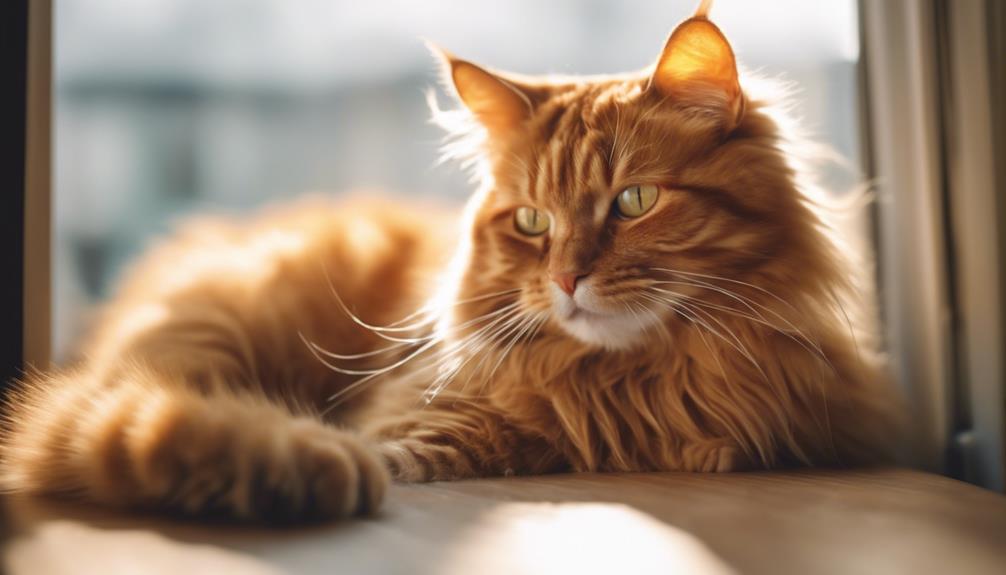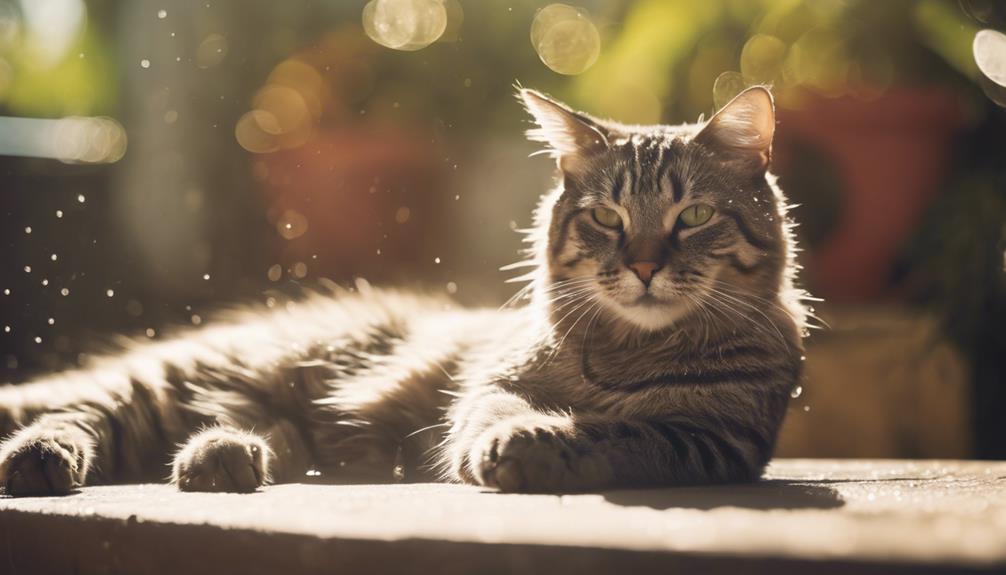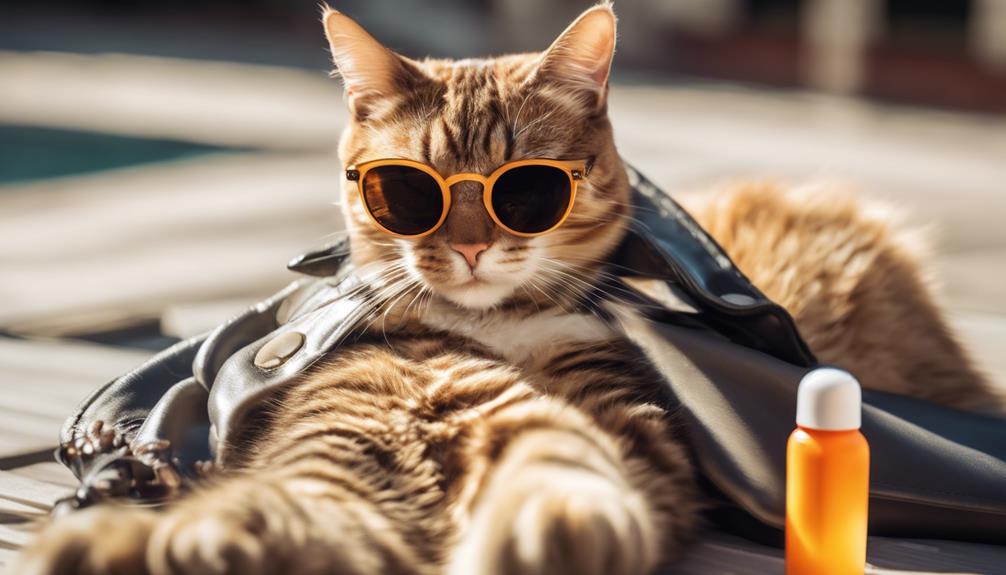In the realm of feline physiology, the question of whether cats sweat may seem straightforward, yet the intricacies of their thermoregulatory mechanisms unveil a more nuanced narrative.
While cats may not perspire through their skin as humans do, a closer examination reveals how these enigmatic creatures employ alternative strategies to cope with heat stress.
By peeling back the layers of cats' cooling methods, a deeper understanding emerges, prompting us to ponder the implications of their unique physiological adaptations.
This exploration delves into the enigmatic world of feline thermoregulation, offering a glimpse into the intricate dance between cats and heat.
Key Takeaways
- Cats do not sweat through their skin like humans but use alternative cooling methods.
- Sweat glands on their paw pads release moisture for cooling effects.
- Paw pad sweat is crucial for cats' thermoregulation, aiding in heat dissipation.
- Panting in cats may signal distress or underlying health issues, not primarily for cooling.
Cats' Sweat Glands and Cooling Mechanisms
Cats employ a combination of unique cooling mechanisms, including minimal sweat secretion through their foot pads and self-grooming techniques, to regulate their body temperature efficiently. Sweat glands on the bottom of their paw pads play a crucial role in this process by releasing small amounts of moisture when necessary. However, compared to humans, cats rely more on other methods like panting, grooming, and seeking out cool surfaces to dissipate heat.
Understanding these natural cooling strategies can help cat owners provide a comfortable environment for their feline companions, especially during hot weather. By recognizing when their cat might be experiencing distress from overheating and taking proactive steps to cool them down, pet owners can ensure their beloved pets stay healthy and happy.
Understanding Cats' Paw Pad Sweat
Employing a unique combination of cooling mechanisms, cats utilize their paw pad sweat glands as part of their efficient body temperature regulation. Cats' paw pads play a crucial role in their cooling process, allowing them to dissipate heat effectively. This sweat, although minimal, aids in cooling down their bodies during hot weather or intense physical activity.
- Cats' paw pad sweat glands help regulate body temperature.
- The sweat produced through paw pads evaporates, providing a cooling effect.
- Cats may lick their paw pads to enhance the cooling sensation.
- Paw pad sweat glands are an essential part of cats' thermoregulation system.
Signs of Distress: Panting in Cats

Panting in cats is a significant indicator of distress, signaling potential underlying issues that require attention and care. Unlike dogs, cats do not typically pant as a cooling mechanism. When a cat is panting, it could be a sign of stress, overheating, or an underlying medical condition.
Prolonged or intense panting in cats should not be ignored, as it may indicate a serious problem that requires veterinary intervention. Other signs of distress to look out for in conjunction with panting include lethargy, drooling, and restlessness.
If you notice your cat panting excessively, especially if it is accompanied by other concerning symptoms, it is crucial to seek prompt medical attention to ensure the well-being of your feline companion.
Recognizing Emergency Signs in Cats
Recognizing critical indicators of distress in felines can be crucial for ensuring timely intervention and proper care for your cat's well-being. When it comes to recognizing emergency signs in cats, here are some key points to keep in mind:
- Sudden changes in behavior or activity levels.
- Difficulty breathing or rapid breathing.
- Unusual vocalizations or excessive meowing.
- Refusal to eat or drink.
Being attentive to these signs and acting promptly can make a significant difference in your cat's health and well-being.
If you notice any of these signs, it's essential to contact your veterinarian for guidance and appropriate care.
Hot Weather Care for Cats

During hot weather, ensuring appropriate care for your feline companion becomes paramount to safeguard their well-being and comfort. Cats are sensitive to heat and can easily become overheated, leading to heatstroke or dehydration.
To care for your cat in hot weather, provide access to a cool and shaded area, ample fresh water, and adequate ventilation. Be mindful of signs of distress such as excessive panting, lethargy, or drooling, as these could indicate heat-related issues.
Additionally, consider grooming your cat to help them cool down and prevent matting of their fur, which can trap heat. By taking these precautions and being attentive to your cat's needs, you can ensure they stay comfortable and healthy during warmer months.
Keeping Cats Cool and Hydrated
To ensure your cat's comfort and well-being during hot weather, it is crucial to focus on keeping them cool and hydrated. Here are some tips to help you achieve this:
- Provide access to fresh water at all times.
- Create cool areas in your home for your cat to rest.
- Use elevated surfaces or cat beds in well-ventilated areas.
- Consider using interactive water fountains to encourage hydration.
Sun Protection for Cats

When safeguarding your feline companion from the sun's harmful rays, providing adequate sun protection is essential for maintaining their well-being and health. Cats, especially those with light-colored fur or skin, are prone to sunburns and skin cancer from excessive sun exposure.
To protect your cat, provide shaded areas for them to rest outdoors, limit their time in direct sunlight, and consider pet-safe sunscreen for vulnerable areas like the nose and ears. Additionally, investing in cat-specific sun hats or clothing with UPF protection can offer extra defense against UV rays.
Heatstroke Awareness and Prevention
Heatstroke in cats is a serious condition that requires prompt recognition and preventive measures to safeguard their health and well-being.
To prevent heatstroke in cats, consider the following:
- Provide access to cool and shaded areas.
- Ensure an adequate supply of fresh water.
- Avoid leaving cats in hot cars or enclosed spaces.
- Monitor your cat's behavior for signs of overheating.
Frequently Asked Questions
Can Cats Get Sunburned on Their Paw Pads From Sunbathing?
Cats' paw pads can get sunburned from prolonged sun exposure. Protect their sensitive pads with pet-safe sunscreen or limit sun exposure. Watch for signs of discomfort and contact a vet if needed for proper care.
Is It Safe to Use Fans or Air Conditioning to Cool Down Cats in Hot Weather?
It is safe to use fans or air conditioning to cool down cats in hot weather. Ensure proper ventilation, avoid direct airflow, and provide a comfortable environment. Monitor your cat's behavior for any signs of discomfort or stress.
Are There Specific Breeds of Cats That Are More Prone to Heatstroke?
Certain cat breeds, like Persians and Himalayans, with thick fur coats are more prone to heatstroke. Vigilance in hot weather is crucial for all cats, but especially for those predisposed to overheating due to their breed's characteristics.
Can Cats Suffer From Dehydration Even if They Have Access to Water?
Cats can suffer from dehydration even with water access due to inadequate intake or underlying health issues. Monitoring water consumption, ensuring fresh water availability, and seeking veterinary care if signs of dehydration appear are crucial.
How Can I Create a Cool and Comfortable Outdoor Space for My Cat During Summer?
To create a cool outdoor space for your cat during summer, provide shade, fresh water, and proper ventilation. Use cooling mats or fans, ensure access to a shaded area, and avoid direct sun exposure. Regularly monitor your cat for signs of overheating.
Conclusion
In conclusion, feline thermoregulation is a complex process that relies on unique cooling mechanisms such as paw pad sweat. Recognizing signs of distress in cats, such as panting, is crucial for preventing heat-related ailments.
By understanding how cats manage heat and implementing appropriate care measures, pet owners can safeguard their feline companions' well-being in varying environmental conditions. Awareness of heatstroke prevention and sun protection is vital for ensuring cats remain cool, hydrated, and healthy.




